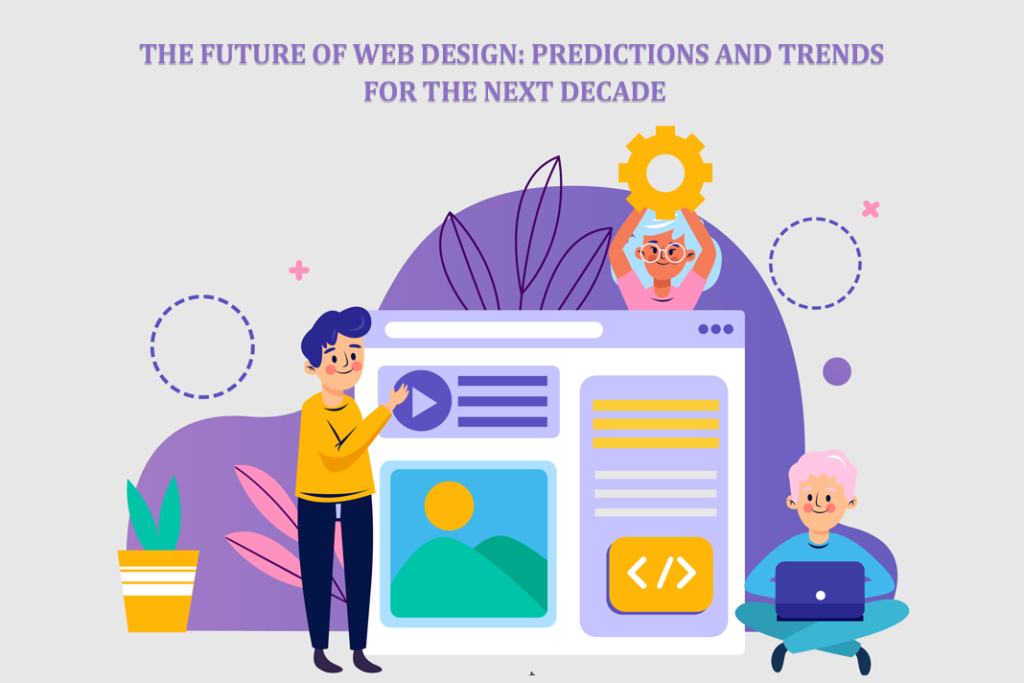This is a guest post.

The web is transforming into a dynamic ecosystem. Lines blur between websites and immersive experiences, AI whispers personalised suggestions, and design choices carry the weight of environmental responsibility. Buckle up; the next decade of web design promises to be an exciting and unpredictable ride.
In this article, we’ll look at major trends and predictions for the next decade. We’ll briefly look at the benefits of keeping up with major trends. Then, we’ll focus on technological advancements, changing user expectations, and evolving design aesthetics in web design.
Advantages of Keeping Updated
Before diving into the article, let’s consider why you need to read this article. There are many benefits to monitoring the prediction and future trends. Some are as follows:
● Competitive advantage
● Increased creativity
● Future-proof skillset and technologies
● Effective marketing strategies
● Higher conversion rates
● Informed investments
● Building brand loyalty
● Enhanced user interaction
● Staying relevant
All of this will contribute hugely to your company. If you focus on higher conversion rates, you can implement engaging WooCommerce Popup Carts that showcase added items and encourage further shopping.
Technological Advancements
How we experience the web is about to get a significant overhaul, driven by exciting technological advancements. In this section, let’s delve into four technological advancements redefining web design in the next decade.
AI and Personalisation
This technological advancement allows website owners to create content and layout tailored to customers’ preferences. For example, the top suggestions would be articles the customers would love to read and products they’d use.
It works through AI algorithms, which analyse vast amounts of data, including user behaviour and design trends. This allows the AI to automatically generate personalised layouts, colour palettes, and design elements. It’s like having a virtual design assistant working to optimise your website for maximum engagement constantly.
AI can go beyond layout, churning out personalised content like blog posts, product descriptions, and video scripts based on user preferences and real-time data. It saves time and resources while ensuring content resonates with your audience.
Immersive Technologies
These technologies allow you to create interactive and engaging experiences for your website’s visitors. Augmented Reality (AR) and Virtual Reality (VR) are two technologies that help create experiences that blur the lines between the digital and physical world.
AR will transform e-commerce, education, and entertainment in the next decade. Thus, web design must adapt to create seamless and intuitive AR experiences. For example, consider overlaying virtual elements onto your physical surroundings, trying on clothes virtually, or exploring a museum exhibit right from your living room.
VR technology enables people to attend virtual concerts, explore interactive stories, or collaborate with colleagues in a virtual workspace. Web design must master spatial storytelling and user interaction to create compelling VR experiences.
Voice Search Optimisation
As voice assistants become increasingly popular, websites must adapt to how people search for information. This means optimising content for natural language queries, focusing on long-tail keywords, and ensuring intuitive and engaging voice interfaces.
Thus, websites will need to have a more conversational design. In the future, web design must focus on micro-interactions like quick answers and voice-activated buttons.
Progressive Web Apps (PWAs)
PWAs are apps made using web platform tech. They feel like a native app and offer offline functionality, push notifications, and a faster, more responsive experience.
PWAs blur the lines between websites and apps, offering a frictionless user experience regardless of device or internet connection. This leads to higher engagement and conversions, making PWAs a must-have for future web design.
Moreover, PWAs load faster and work offline, making them more accessible to users with limited bandwidth or disabilities.
Shifting User Expectations
The future of web design isn’t just about technology; it’s about understanding and catering to the ever-evolving expectations of the people using it. Let’s look at some aspects shaping how users will interact with the web in the upcoming decade.
Accessibility and Ethical Considerations
As technology advances, it is necessary to ensure everyone benefits equally. Users are expecting accessibility and ethical considerations in every aspect of web design.
For this, websites will have an inclusive design, with features like screen readers, keyboard navigation, and clear visuals for low-vision users.
Micro-Interactions and Storytelling
In the future, delightful micro-interactions and captivating narratives will become the foundation of engaging user experiences.
Micro-interactions will act as emotional touchpoints, creating a sense of playfulness and delight and weaving user emotion into the very fabric of the website. The shift towards interactive storytelling means that websites will transition from static information hubs to immersive storytelling platforms.
Focus on Emotions and Connection
Design isn’t just about aesthetics but forging emotional connections with users. The future web will leverage design elements to evoke empathy, build trust, and create meaningful relationships.
Website owners must understand user psychology to apply principles like colour psychology, visual hierarchy, and emotional white space. Trust and credibility building is also necessary. Design elements like transparency, user testimonials, and clear communication make users feel safe and secure while interacting with the website.
Data-Driven Design and User Analysis
In the age of big data, understanding user behaviour is no longer guesswork. Web design will increasingly integrate data analytics to tailor experiences and optimise engagement.
Websites will learn and adapt in real-time, using data to personalise content, test different design elements, and optimise the user experience based on individual preferences and interaction patterns.
Analytics will predict user intent and anticipate needs, allowing for proactive design adjustments like pre-filling forms or recommending relevant content before users ask.
The Rise of Micro-Communities and Niche Audiences
The web is no longer a homogeneous space; it’s a tapestry of micro-communities with specific interests and values. Web design must cater to these niche audiences, creating experiences that resonate and foster belonging.
Understanding niche communities’ unique needs and preferences allows for tailored design elements, targeted messaging, and a sense of community built into the website. Websites that can be customised and shaped by the community they serve are part of the future. They will allow users to contribute content, design elements, and ideas, fostering a sense of ownership and belonging.
Evolving Design Aesthetics
The visual language of the web is in constant flux, reflecting technological advancements, evolving cultural currents, and user preferences. In this section, we’ll dive into some aesthetic trends that will colour the landscape of future web design.
Minimalism with a Twist
Minimalism isn’t going anywhere, but it’s evolving. The clean lines and ample white space are still there but infused with refined functionality and subtle personality.
In the future, minimalism will focus on crafting visually sleek, efficient, and intuitive interfaces. While avoiding visual overload, designers inject subtle flourishes that hint at brand identity or user preference.
Bold Colours and Typographic Adventures
While minimalism holds its ground, the future web embraces boldness, using vibrant colours and experimental typography to grab attention and leave a lasting impression.
Forget muted tones and expect websites that burst with life through daring colour combinations, gradients, and playful use of negative space. This trend embraces diversity and individuality, reflecting the vibrant tapestry of global audiences. The usage of fonts is changing as they become statement pieces. Websites will experiment with unconventional typefaces, dynamic sizing, and interactive typography that responds to user behaviour.
Sustainable Design Choices
As environmental consciousness grows, web design is becoming more responsible. This means choosing eco-friendly materials and adopting design practices that minimise environmental impact. Therefore, sustainable alternatives like recycled paper, organic inks, and energy-efficient hosting options are becoming mainstream considerations in creating environmentally responsible websites.
Every pixel and line of code has an environmental footprint. You should expect future web design to prioritise code optimisation, faster loading times, and resource-efficient practices to reduce the carbon footprint of the digital world.
Conclusion
The web promises a thrilling evolution as we move steadily towards the next decade. The future of web design will involve technological advancements like AR and VR, user expectations shifting to accessibility considerations, and design aesthetics like minimalism. So, prepare for the future to be a collaboration where creativity dances with technology, responsibility fuels innovation, and every click becomes a step towards a more vibrant, inclusive, and sustainable digital world.

